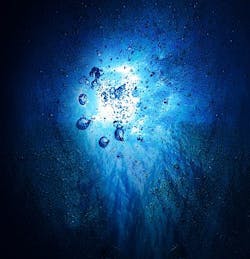DARPA to brief industry on Upward Falling Payloads (UFP) program 25 Jan. in Arlington, Va.
ARLINGTON, Va., 17 Jan. 2013. Underwater munitions experts at the U.S. Defense Advanced Research Projects Agency (DARPA) in Arlington, Va., will brief industry about a new program to pre-deploy sensors or non-lethal weapons on the ocean floor that can rise to the surface at a moment's notice to surprise naval adversaries from 8 a.m. to noon on 25 Jan. 2013 at the DARPA Conference Center, Room 01-200, 675 N. Randolph St., in Arlington Va.
The proposers' day conference is to provide information on the Upward Falling Payloads (UFP) program, which seeks to design non-lethal weapons and situational-awareness sensors that pop up on the surface seemingly without warning from the ocean's depths in the middle of enemy naval battle groups.
The UFP program industry briefings also are to promote additional discussion and to address questions from potential proposers.
Sensors and non-lethal weapons such as distracting light strobes, blinding lasers, electronic warfare jammers would be designed under the UFP program for placement on the ocean floor, with propellant to launch payloads to the ocean surface, and communications systems that enable their deployment at standoff ranges.
The primary reason for the UFP program is the high cost and logistical difficulty of deploying many Navy ships and weapons in forward operating areas of vast global ocean areas. Instead, DARPA wants upward falling unattended sensor or non-lethal weapon payloads pre-deployed for use at a moment's notice.
Concealment of the sea provides the opportunity to surprise maritime targets from below, as well as the ability to operate across great distances, DARPA researchers say. Getting close to targets without warning, and deploying systems without delay are key attributes of anticipated UFP capability.
To succeed, the UFP program must be able to demonstrate a system that can survive for years under extreme pressure; be triggered from standoff commands; and rapidly rise through the water and deploy a non-lethal weapon or sensor payload.
The UFP system is envisioned to consist of three key subsystems: the payload, which carries out ocean or air applications after deployment; the UFP riser, which launches the payload from the ocean floor to ocean's surface; and the UFP communications that triggers the UFP riser to launch.
The first phase of the UFP program should lead to conceptual designs and feasibility assessments. UFP communications will be key. The second phase will develop major UFP subsystems, and demonstrate a UFP riser and communications. The third phase will integrate UFP communications and UFP subsystems to full depth and communications capability.
The UFP program's second phase should develop subsystems at a technology readiness levels (TRL) of four to five. the third phase should develop subsystems at TRL six.
Companies interested in attending the UFP industry day briefings should register online no later than noon 22 Jan. 2013 at www.solers.com/BAAinfo-reg/UFP. Attendance is free.
All attendees must present government-issued photo identification and U.S. citizenship verification form on entry. Non-U.S. citizens are not allowed. Attendance is not required to submit a proposal for the UFP program.
Companies interested in submitting bids for the UFP program should send abstracts no later than 5 Feb. 2013 to DARPA/STO, 675 North Randolph Street, Arlington, VA 22203-2114 (Attn.: BAA 13-17). Full proposals are due to the same address no later than 12 March 2013. E-mail questions or concerns to DARPA at [email protected]. More information is online at https://www.fbo.gov/spg/ODA/DARPA/CMO/DARPA-BAA-13-17/listing.html.
More information is online at https://www.fbo.gov/spg/ODA/DARPA/CMO/DARPA-SN-13-18/listing.html.

